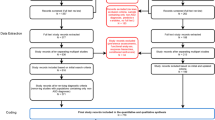Abstract
This study used the correlated trait-correlated method minus one model to examine the convergent and discriminant validity of the Child Behavior Checklist (CBCL), Teacher’s Report Form (TRF) and Youth Self-Report (YSR), based on ratings of clinic-referred adolescents. A total of 294 adolescents, comprising 70.5 % males, provided self-ratings on the YSR. The adolescents were also rated by their mothers and teachers on the CBCL and TRF respectively. The findings indicated some support for convergent validity for the CBCL and TRF for Anxious/Depressed, Withdrawn/Depressed and Rule Breaking Behavior, and for the convergent validity for the CBCL and YSR for Rule Breaking Behavior. There was support for the discriminant validity between virtually all the traits. The findings are discussed in relation to the construct validity, cross-informant agreement, and clinical use of the CBCL, TRF and YSR.

Similar content being viewed by others
References
Achenbach, T. M., & Dumenci, L. (2001). Advances in empirically based assessment: Revised cross-informant syndromes and new DSM-oriented scales for the CBCL, YSR, and TRF: Comment on Lengua, Sadowksi, Friedrich, and Fisher. Journal of Consulting and Clinical Psychology, 69, 699–702.
Achenbach, T. M., & Rescorla, L. A. (2001). Manual for the ASEBA School-Age Forms & Profiles. Burlington: University of Vermont, Research Center for Children, Youth, and Families.
Achenbach, T. H., McConaughy, S. H., & Howell, C. Y. (1987). Child/adolescent behavior and emotional problems: Implications for cross-informant correlations for situational specificity. Psychological Bulletin, 101, 213–232.
Achenbach, T. M., Dumenci, L., & Rescorla, L. A. (2002). Ten-year comparisons of problems and competencies for national samples of youth: Self, parent and teacher reports. Journal of Emotional and Behavioral Disorders, 10, 194–203.
Achenbach, T. M., Becker, A., Dopfner, M., et al. (2008). Multicultural assessment of child and adolescent psychopathology with ASEBA and SDQ instruments: research findings, applications, and future directions. Journal of Child Psychology and Psychiatry, 49, 251–275.
American Psychiatric Association. (2000). Diagnostic and statistical manual of mental disorders – IV text revised. Washington: Author.
Brown, T. A. (2006). Confirmatory factor analysis for applied research. New York: Guilford Press.
Campbell, D. T., & Fiske, D. W. (1959). Convergent and discriminant validation by the multitrait-multimethod matrix. Psychological Bulletin, 2, 81–105.
Choudhury, M. S., Pimentel, S. S., & Kendall, P. C. (2003). Childhood anxiety disorders: Parent–child (dis) agreement using a structured interview for the DSM–IV. Journal of the American Academy of Child & Adolescent Psychiatry, 42, 957–964.
De Los Reyes, A., & Kazdin, A. E. (2005). Informant discrepancies in the assessment of childhood psychopathology: A critical review, theoretical framework, and recommendations for further study. Psychological Bulletin, 131, 483–509.
Eid, M., Lischetzke, T., Nussbeck, F. W., & Trierweiler, L. I. (2003). Separating trait effects from trait-specific method effects in multitrait–multimethod models: A multiple-indicator CT-C (M–1) model. Psychological Methods, 8, 38–60.
Epkins, C. C. (1993). A preliminary comparison of teacher ratings and child self-report of depression, anxiety, and aggression in inpatient and elementary school samples. Journal of Abnormal Child Psychology, 21, 649–661.
Grigorenko, E. L., Geiser, C., Slobodskaya, H. R., & Francis, D. J. (2010). Cross-Informant symptoms from CBCL, TRF, and YSR: Trait and method variance in a normative sample of Russian youths. Psychological Assessment, 22, 893–911.
Grills, A. E., & Ollendick, T. H. (2002). Issues in parent– child agreement: The case of structured diagnostic interviews. Clinical Child and Family Psychology Review, 5, 57–83.
Hancock, G. R. (2006). Power analysis in covariance structure modelling. In G. H. Hancock & R. O. Mueller (Eds.), Structural equation modeling: A second course. Greenwich: Connecticut. IAP Publication.
Hemphill, J. F. (2003). Interpreting the magnitudes of correlation coefficients. American Psychologist, 58, 78–79.
Hu, L. T., & Bentler, P. M. (1998). Fit indices in covariance structure modeling: Sensitivity to underparameterized model misspecification. Psychological Methods, 3, 424–453.
Lance, C. E., Noble, C. L., & Scullen, S. E. (2002). A critique of the correlated trait-correlated method and correlated uniqueness models for multitrait-multimethod data. Psychological Methods, 7, 228–244.
Little, T. D., Cunningham, W. A., Shahar, G., & Widaman, K. F. (2002). To parcel or not to parcel: Exploring the question, weighing the merits. Structural Equation Modeling, 9.
Lord, F. N., & Novick, M. R. (1968). Statistical theories of mental test scores. Reading: Addison-Wesley.
Marsh, H. W., Lüdtke, O., Nagengast, B., Morin, A. J. S., & Von Davier, M. (2013). Why item parcels are (almost) never appropriate: Two wrongs do not make a right-camouflaging misspecification with item parcels in CFA models. Psychological Methods, 18, 257–284.
Muthen, L. K., & Muthen, B. O. (2010). Mplus user’s guide (6th ed.). Los Angeles: Muthen & Muthen.
Sawyer, M. G., Baghurst, P., & Mathias, J. (1992). Differences between informants’ reports describing emotional and behavioural problems in community and clinic-referred children: A research note. Journal of Child Psychology and Psychiatry, 33, 441–449.
Silverman, W. K., & Albano, A. M. (1996). Manual for the ADIS-IV C/P. New York: Psychological Corporation.
Silverman, W. K., Saavedra, L. M., & Pina, A. A. (2001). Test–retest reliability of anxiety symptoms and diagnoses with the Anxiety Disorders Interview Schedule for DSM-IV: child and parent versions. Journal of the American Academy of Child and Adolescent Psychiatry, 40, 937–944.
van den Ende, J., & Verhulst, F. C. (2005). Informant, gender and age differences in ratings of adolescent problem behaviour. European Child and Adolescent Psychiatry, 14, 117–126.
Conflict of Interest
The authors declare that they have no conflict of interest.
Author information
Authors and Affiliations
Corresponding author
Rights and permissions
About this article
Cite this article
Gomez, R., Vance, A. & Gomez, R.M. Analysis of the Convergent and Discriminant Validity of the CBCL, TRF, and YSR in a Clinic-Referred Sample. J Abnorm Child Psychol 42, 1413–1425 (2014). https://doi.org/10.1007/s10802-014-9879-4
Published:
Issue Date:
DOI: https://doi.org/10.1007/s10802-014-9879-4



